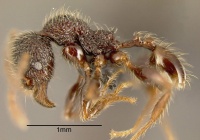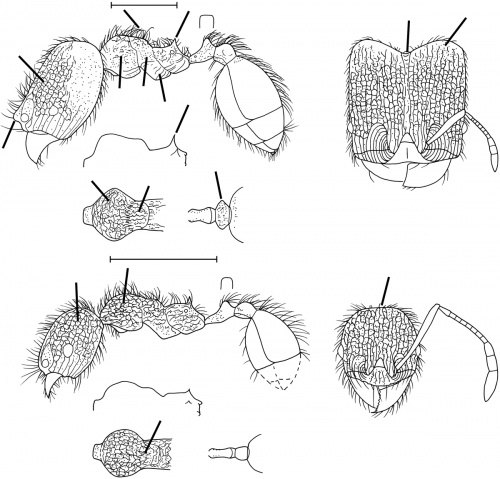Pheidole traini
| Pheidole traini | |
|---|---|

| |
| Scientific classification | |
| Kingdom: | Animalia |
| Phylum: | Arthropoda |
| Class: | Insecta |
| Order: | Hymenoptera |
| Family: | Formicidae |
| Subfamily: | Myrmicinae |
| Tribe: | Attini |
| Genus: | Pheidole |
| Species: | P. traini |
| Binomial name | |
| Pheidole traini Wilson, 2003 | |
According to Longino (1997), , traini occurs in Costa Rica in mature wet forests. Its nesting and feeding habits are unknown. (Wilson 2003)
Identification
See the description in the nomenclature section.
Keys including this Species
Distribution
In addition to the type locality, this species has been reported by Longino (1997), in Costa Rica on the southern Pacific slope. (Wilson 2003)
Latitudinal Distribution Pattern
Latitudinal Range: 8.683333° to 8.683333°.
| North Temperate |
North Subtropical |
Tropical | South Subtropical |
South Temperate |
- Source: AntMaps
Distribution based on Regional Taxon Lists
Neotropical Region: Costa Rica, Panama (type locality).
Distribution based on AntMaps
Distribution based on AntWeb specimens
Check data from AntWeb
Countries Occupied
| Number of countries occupied by this species based on AntWiki Regional Taxon Lists. In general, fewer countries occupied indicates a narrower range, while more countries indicates a more widespread species. |

|
Estimated Abundance
| Relative abundance based on number of AntMaps records per species (this species within the purple bar). Fewer records (to the left) indicates a less abundant/encountered species while more records (to the right) indicates more abundant/encountered species. |

|
Biology
Castes
Nomenclature
The following information is derived from Barry Bolton's Online Catalogue of the Ants of the World.
- traini. Pheidole traini Wilson, 2003: 766, figs. (s.w.) PANAMA.
Unless otherwise noted the text for the remainder of this section is reported from the publication that includes the original description.
Description
DIAGNOSIS Similar in various traits to Pheidole aper, Pheidole bambusarum, Pheidole brevicona, Pheidole dyctiota, Pheidole laeviventris, Pheidole lutzi, Pheidole risii, Pheidole rugatula, Pheidole senilis, Pheidole sigillata, Pheidole trachyderma, differing as follows.
Major: yellow to dark reddish brown; head subrectangular, with almost perfectly straight sides in full-face view; occipital cleft deep, and occipital lobes subangular; in side view frontal lobes project well forward as conspicuous lobes; all of posterior half of dorsal head surface except for occipital margin rugoreticulate; pronotal dorsum rugoreticulate; mesonotal dorsum rugulose; most of sides of mesosoma with scattered short rugulae and carinulae; pilosity very dense, and in mesosoma much of it curved to give a woolly appearance; propodeal spines long, stout, and vertical on propodeal dorsal face.
Minor: all of posterior head surface and pronotum and dorsa of mesothorax and propodeum rugoreticulate; occiput narrowed but lacking nuchal collar.
MEASUREMENTS (mm) Holotype major: HW 1.64, HL 1.80, SL 0.66, EL 0.18, PW 0.96. Paratype minor: HW 0.70, HL 0.70, SL 0.62, EL 0.10, PW 0.50.
COLOR Major: concolorous medium reddish yellow (types) or dark reddish brown (Costa Rica: San Vito).
Minor: head and mesosoma medium reddish yellow, with waist, gaster, and appendages medium yellow (types) to dark reddish brown (Costa Rica: San Vito).
Figure. Upper: holotype, major. Lower: paratype, minor. Scale bars = 1 mm.
Type Material
PANAMA: Cerro Campana, col. William L. Brown. Museum of Comparative Zoology
Etymology
Named in honor of Russell E. Train, pioneer in the modern movement of global conservation.
References
- Wilson, E. O. 2003. Pheidole in the New World: A dominant, hyperdiverse ant genus. Harvard University Press, Cambridge, MA. (page 766, fig. major, minor described)
References based on Global Ant Biodiversity Informatics
- Wilson E. O. 2003. Pheidole in the New World. A dominant, hyperdiverse ant genus. Cambridge, Mass.: Harvard University Press, [ix] + 794 pp.

